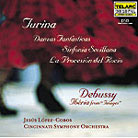February 2002
Joaquín Turina is generally grouped with three other composers, his elders, who were responsible for the renaissance of Spanish music during the late-19th and early-20th centuries: Falla, Albenez and Grandados. Turina met the first two in Paris after the premiere of his Quintet in Paris in 1907. He studied with various teachers in Paris, including Franck and d’Indy and was in has 30s when he composed the works on this CD, Danzas Fàntasticas, Sinfonia Sevillana and La Procesión del Rocio. La Procesión made Turina famous in Spain at its premiere in 1913. It celebrates Seville’s "Procession of the Dew," which honors the Virgin -- its themes taken from Gypsy dances, religious strains and a passage from the Spanish national anthem. It is vibrant, confident, rhythmically powerful music. I prefer the subtler touches of Turina’s two other compositions on the CD, both dating from 1920. In these, the influence of French impressionist music is much more evident, as is Turina’s greater skills with orchestration. This is programmatic music in the best sense of the word, intended to evoke specific scenes, in the case of the Sinfonia, and specific moods, in the case of the Danzas. This, Turina accomplishes brilliantly. On the score for Danzas, for example, he includes lines of poetry with each of the three movements to further illuminate the music. Much could be said of each of these dance movements and of the three movements, beginning with Panorama with its variegated scenes of city and countryside, which constitute the tone-poem-like Sinfonia Sevillana. But the salient point about these compositions, the Danzas and the Sinfonia, is that they do a wonderful job of speaking for themselves. This is music that seems to delight in the act of making music, and not just any music, but the music of a symphony orchestra. The CD is well-recorded, with good soundstaging and decent imaging, though it is by no means up to the very best I've heard. Similarly, while this is unquestionably a good performance by Jesús López-Cobos and the Cincinnati Symphony Orchestra, it is not a great performance. The final ounce of energy and precise rhythmic drive so characteristic of Spanish music is not there; the performance seems to lack that ultimate sense of conviction and understanding. Most performances of classical music do not do ultimate justice to the music, do not achieve real greatness. This does not mean we cannot derive immense pleasure from them. And indeed, for some classical music, great performances may simply not be available. But I am delighted to have been introduced to the orchestral music of Turina and can recommend this CD unhesitatingly for that purpose. GO BACK TO: |
 Music of Turina and
Debussy
Music of Turina and
Debussy![[Reviewed on CD]](../format/regcd.gif) Spanish
music, especially those twin pillars of the Spanish piano repertory Albeniz’s Iberia
and Granados’ Goyescas, has for me an almost magical ability to enchant, to
evoke and reify an exotic world that thrills the senses and soothes the heart. Orchestral
music can have the magic too. Ravel and Debussy are masters of it, so maybe it is
not so curious that I find this quality more prominently in Debussy than in Turina,
particularly Le parfums de la nuit, the second movement of Debussy’s Iberia,
which I think must qualify as one of his greatest compositions. De Falla admired
Debussy’s Iberia, writing, "The entire piece down to the smallest detail
makes one feel the character of Spain." A remarkable tribute to the Frenchman who in
his entire life spent but a single afternoon in Spain, attending a bull fight.
Spanish
music, especially those twin pillars of the Spanish piano repertory Albeniz’s Iberia
and Granados’ Goyescas, has for me an almost magical ability to enchant, to
evoke and reify an exotic world that thrills the senses and soothes the heart. Orchestral
music can have the magic too. Ravel and Debussy are masters of it, so maybe it is
not so curious that I find this quality more prominently in Debussy than in Turina,
particularly Le parfums de la nuit, the second movement of Debussy’s Iberia,
which I think must qualify as one of his greatest compositions. De Falla admired
Debussy’s Iberia, writing, "The entire piece down to the smallest detail
makes one feel the character of Spain." A remarkable tribute to the Frenchman who in
his entire life spent but a single afternoon in Spain, attending a bull fight.